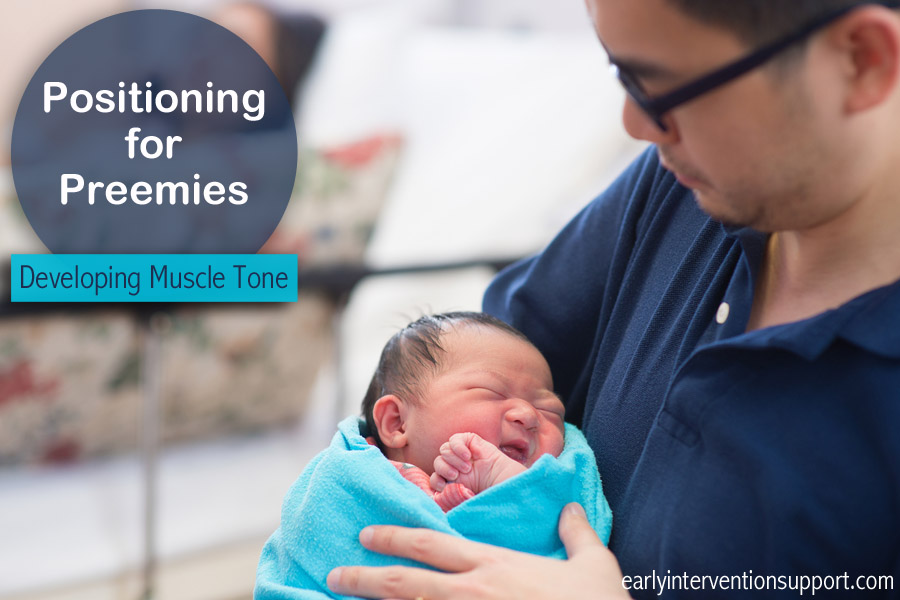Infants born prematurely are met with a difficult situation. They try to grow and develop as they would have if they were still in the womb, however, they are doing so outside the womb. Proper positioning of preemie babies throughout their day can help them to achieve their goals for development and help ease the harshness of the world they were not ready to be introduced to quite yet. NICU nurses are very knowledgeable about positioning preemies, but this positioning needs to be continued at home. Positioning is most important when the baby comes home from the hospital early, perhaps before his original due date.
As babies develop and grow in the uterus they become folded up with their arms and legs flexed in towards their body. This position, along with the baby pushing against the walls of the uterus, creates what is called physiological flexion and provides the baby with muscle tone in their limbs. This helps them to move against gravity without having their arms and legs stuck against the surface that they are laying on. Premature babies most likely do not get big enough to develop this physiological flexion. It is common to see preemies lying with their arms and legs spread out. It is very hard to move against gravity from this position and progress through the steps of motor development. Positioning that promotes physiological flexion can go a long way in helping premature babies to develop the strength and tone they need to do what full term babies do.
Best Positions for Premature Baby Development
When holding or feeding your baby, cradle her so that her shoulders are forward with her arms tucked into her chest and with her legs flexed (bent) at the hips and knees. You can bring her hands near the bottle or breast if she is being fed or near her mouth if she is being cuddled. You can also swaddle your baby in a blanket during these times.
Tummy time, while supervised and awake, is important for all babies including preemies. For some parents it is scary to put their premature baby on his belly, however it will not hurt him if supervised and he will greatly benefit from it in the long run. It may not be easy for the baby or for you but over time your baby will get stronger and you will both become more tolerant of it. The flexed position of your baby’s limbs is also the focus during early tummy time. Make a small roll out of a receiving blanket or towel. Place your baby gently on his belly with the roll at his chest just below his arm pits. Place his arms on the surface on the other side of the roll. Tuck his elbows in so he has weight on his forearms. This will also help bring his hands to his mouth which can soothe him and give sensory input to his hands. Tuck his legs up and under him. Use another “U” shaped roll around his legs to keep him in this position if needed. Get down on the floor with your baby and talk to him to soothe him and to motivate him to try to lift his head. Work towards increased time on his belly. Remember to only do tummy time when your baby is awake & supervised. Babies should always be put down to sleep on their backs unless your physician directs you otherwise.
Although tummy time is very important, babies should also have time playing on their backs. Positioning can help them to be successful during this activity as well. Create a nest for your baby using a boppy pillow or a “U” shaped blanket roll. Your baby’s head should be placed at the center of the curve of the “U” with the free ends of the roll coming down his sides and slightly under him. His arms will rest on top of the roll bringing his shoulders forward and arms in. This will help with reaching and hand to mouth activities. The roll should not be too big or too far under your baby as to cause him to lie on top of it. He should rest inside the “U” with his head slightly flexed (chin towards chest) and arms in position on his chest. Another small roll can be placed under his knees to create flexion at his hips and knees.
As your baby grows stronger he will be able to move and hold his position against gravity. As you notice your baby positioning himself in flexion without the help of blanket rolls, you can begin to decrease the use of the rolls during play. The passive positioning you create with these rolls will be replaced by active positioning by the baby himself such as pushing up on his forearms during tummy time and reaching for his toes while on his back. Happy Positioning!
By: Jaime Ruffing, PT

